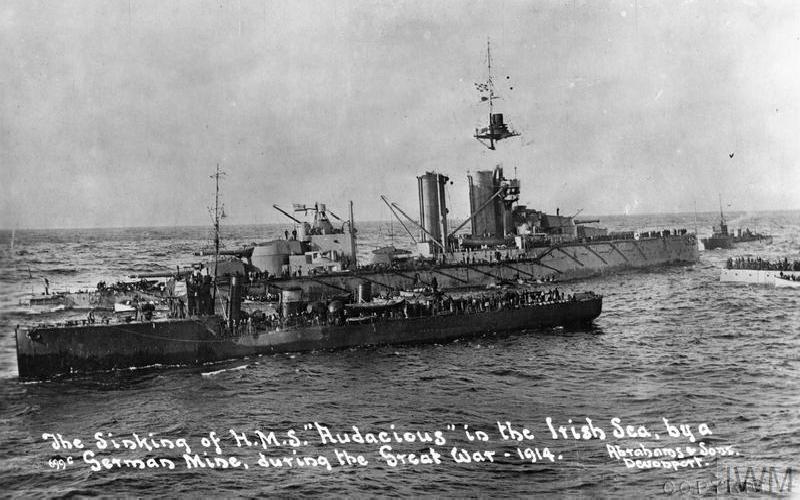Covered up sinking of British battleship


Both the British and the Germans spent a fortune on their navies before the First World War began. It was expected that a great naval battle could win the war.
A mighty ship
At the start of the First World War HMS Audacious was one of the Royal Navy's most up to date battleships. It was decided that these expensive Dreadnoughts needed extra gunnery practice. She was part of the Iron Duke class armed with eight 13.5 inch guns.
This magnificent ship had only been built as a result of the Anglo – German Naval Arms Race, which had done so much to damage the relationship between Britain and Germany. Until the new Queen Elizabeth class were completed the Iron Dukes were the most powerful ships in the Grand Fleet. Indeed Admiral John Jelicoe it's commander made HMS Iron Duke his flagship. The Royal Navy still had more Dreadnoughts than the Germans did but did not want to lose any of them.
An unexpected loss
The Admiralty feared the German surface fleets and submarine but was not overly concerned about the danger posed by magnetic mines.
All that changed on 27th October 1914 when Audacious and seven other battleships went into the North Sea to fire at targets. She struck a mine and was abandoned by the crew. They were put on other ships in the hope she could be saved. The ship did not sink until the following day but only one of her sailors had died (unlucky enough to be hit by a piece of debris after she exploded).
An expert cover up
The Admiralty decided to cover up the loss of a major ship by maintaining fake radio signals to and from the Audacious for the remainder of the war that fooled the Germans into believing she was still afloat.
At the time she struck the mine an American cruise ship was nearby. The Royal Navy requested to board that ship, with the crew and passengers promising not to spread the news. In return the British paid compensation for the film and photos they destroyed.
Bibliography
Massie R K (2005) Castles of Steel - Britain, Germany and the winning of the Great War at Sea, Pimlico, London
It is impossible to understand India without first recognizing the overarching centrality of Indian family in its society. While families are universally present in human civilization, in India they went to the extent of subsuming individuality of its people in favor of family.
If you have ever wondered if there are any passages that plainly show Christ is God then look no further. In this article we have eight and if you read them for what they obviously say, it is easy to conclude Christ is God..
Expensive liquid hand washes and soaps do not seem to get rid of fish odor off your hands. Do not panic, this article provides a detailed perspective on how to get rid of fish smell off your hands and vessels without spending a fortune.